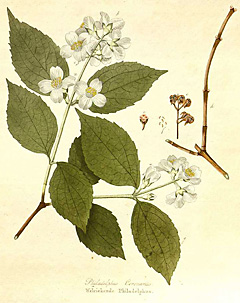Mendacious Mock Orange
By Audrey Stallsmith

Shrubs there are
Of bolder growth, that, at the call of spring,
Burst forth in blossom’d fragrance: lilacs robed
In snow white innocence or purple pride;
The sweet syringa yielding but in scent
To the rich orange. . .
“Book the Third” by William Mason
Strangely enough, the mock orange (Philadelphus coronarium) used to be called syringa, though it bears no relation to the lilac which goes by that genus name. However, syringa derives from syrinx (“pipe”), in reference to the fact that the pith in the branches of both plants can easily be removed to produce hollow reeds. That’s how the above poet could mention both lilacs and syringa in the same stanza—and be referring to two completely different shrubs!
In his 1597 Herball, John Gerard managed the confusion by calling Philadelphus “white pipe privet” and the lilac “blue pipe privet.” As his familiarity with the plant implies, the mock orange has been around as long as horticulture has.
Even back in 1840 John Claudius Loudon referred to it in The Derby Arboretum as “one of the oldest shrubs in cultivation,” noting that it was “found in almost every garden from Lisbon to Naples.” Its genus name doesn’t derive from the Pennsylvania city but from Ptolemy Philadelphus, a Pharaoh who reigned from 285 to 246 B. C.
The deciduous shrub has what you might call classic good looks with very, uhm, leaf-shaped leaves and single, white, four-petal flowers with yellow stamens in late spring and early summer. Those leaves reportedly taste like cucumbers, though I’ve never nibbled on any.
The flowers smell like orange blossoms, whose scent sometimes is called neroli. That explains the “mock orange” common name and why Philadelphus stands for “counterfeit” in the Language of Flowers. For those of us who live in too cold a climate for oranges, however, the shrub makes an easy-growing--though less fruitful--substitute.
Poet William Cowper called it “syringa, ivory pure” in "The Winter Walk at Noon." Now that I think of it, though, ivory is one of the “off” shades of white, and other writers didn’t seem so convinced of the plant’s innocence. Gerard described the flowers as having “a pleasant sweet smell; but in my judgment they are too sweet, troubling and molesting the head in very strange manner. . .so that I could not rest till I had cast them out of my chamber.”
In an 1803 book On Planting and Rural Ornament, William Marshall remarked that “These flowers are very improper for chimneys, water glasses, & in rooms; for in those places their scent will be too strong; and for the ladies in particular, often too powerful.” Apparently we females can’t be trusted around strong fragrances.
Even the more modern poet, Louise Gluck complained about mock orange blooms, comparing them to sex. She apparently considered both too overpowering!
Coronarium means “crown,” however, and this species of Philadelphus is sometimes called garland mock orange. So wreathes of the pristine flowers probably crowned the heads of brides and other celebrants in the past.
Our mock orange bush seems whitely innocent enough, though nobody remembers who planted it, so a little bird may have done so. The shrub grows, appropriately enough, in close proximity to our white lilac. In the future, I shall have to refer to them as white pipe privet and white pipe privet!”
The Philadelphus coronarium image is from the 1840 Afbeeldingen der Fraaiste, Meest Uitheemsche Boomen en Heesters (Images of the Finest , Most Outlandish Trees and Shrubs) by J. C. Krauss, courtesy of plantillustrations.org








